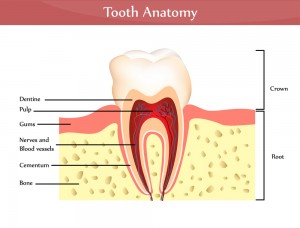 When you visit your dentist, do you feel like you’re in the dark? You don’t need to know what’s going on. You open your mouth, say “Ah,” and your dentist takes it from there. He or she knows what they are doing and we trust our dentist. It may be helpful, however, to be familiar with the anatomy of a tooth in case you need to make a decision concerning treatment. In today’s blog, your Livonia, MI dentist, Dr. James Stewart, is going to explain the basics of tooth anatomy.
When you visit your dentist, do you feel like you’re in the dark? You don’t need to know what’s going on. You open your mouth, say “Ah,” and your dentist takes it from there. He or she knows what they are doing and we trust our dentist. It may be helpful, however, to be familiar with the anatomy of a tooth in case you need to make a decision concerning treatment. In today’s blog, your Livonia, MI dentist, Dr. James Stewart, is going to explain the basics of tooth anatomy.
Tooth Anatomy
A tooth is made up of many layers of which–from the inside out–are the dental pulp, dentin, the root, the crown, cementum, and enamel.
Dental Pulp
The dental pulp is a tiny mass of living connective tissue, blood vessels, and nerves at the very center of the tooth. The pulp is very sensitive because it consists of large nerve trunks. In fact, it is commonly called “the nerve.” The blood vessels and nerves in the dental pulp connect to the jaw through tiny openings in the bottom of the tooth’s roots.
Dentin
Dentin is the tooth structure that encloses the pulp. It is a calcified tissue consisting of microscopic fluid filled tubules. If tooth decay is left untreated and passes through the enamel into the fluid filled tubules, the rate of decay and the sensation of pain can increase.
Root And Crown
The tooth is made up of the root and crown. The root of the tooth remains within the gum when the tooth erupts. The shape of the root depends on the shape of the tooth. The root sits in a socket in the jaw bone and is held there by the periodontal ligament. The tooth crown is the white tooth structure that shows above the gumline. The shape of the crown is determined by the type of tooth: front teeth are flat with a sharp edge, canines are sharp pointed teeth used for tearing, and molars are flat with sharp points for grinding.
Enamel
Enamel is the clear, hard, mineral substance on the crown that shields the dentin from harmful bacteria. It is the outermost surface layer of the tooth, and protects your teeth against tooth decay.
Cementum
The root of the tooth is not protected by enamel. Its first line of defense is the gingival tissue (the gums). Its second line of defense is a thin layer of cementum. Cementum covers the dentin that forms the root structure. It is a specialized, calcified substance that is not as hard as enamel. Therefore, if the root becomes exposed it can be sensitive to heat and cold, and vulnerable to decay.
About Dr. Stewart
James R. Stewart, Jr, DDS, PC and our compassionate staff proudly serve patients of all ages from Livonia, Farmington Hills, Plymouth, Northville, Dearborn Heights, Garden City, and all surrounding communities. To schedule an appointment, call our office today at (734) 425-4400.


